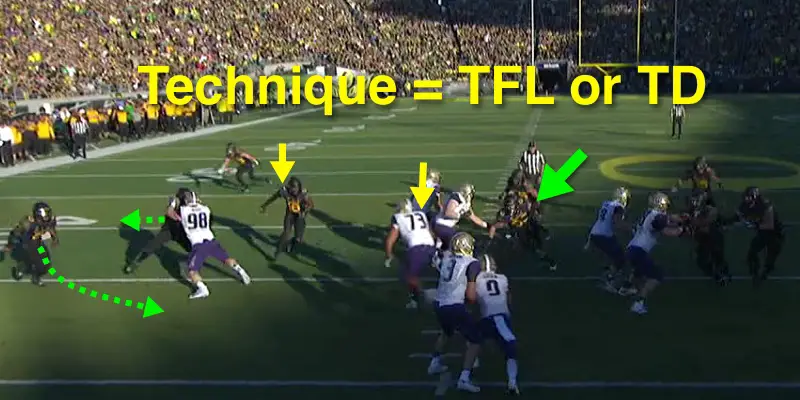Our beloved Oregon Ducks are going through some historic defensive difficulties, yet offer glimmers of hope that they will become better on this side of the ball. Today we look at the leverage of Oregon’s linebackers (courtesy of the Grizzled Ol’ Coach, Mike Morris) and learn how their gap assignments can be solved by looking at both good and bad examples.
A fundamental concept of linebacking is “filling and spilling,” as linebackers will fill their assigned gap and spill the play to the outside for waiting edge defenders. In essence linebackers want to make opposing running backs attempt to bounce their run to the outside.

Oregon’s defense is lined up correctly.
The Ducks are lined up above in their usual defense with a defensive tackle in the “3 technique” position on the outside shoulder of the offensive guard, and the defensive end on the outside shoulder of the tight end in a “9 technique.” Note the positioning of the right linebacker, as he is the focus on this play. Oregon also has a corner blitz about to take place, as well, with the green dotted line above.
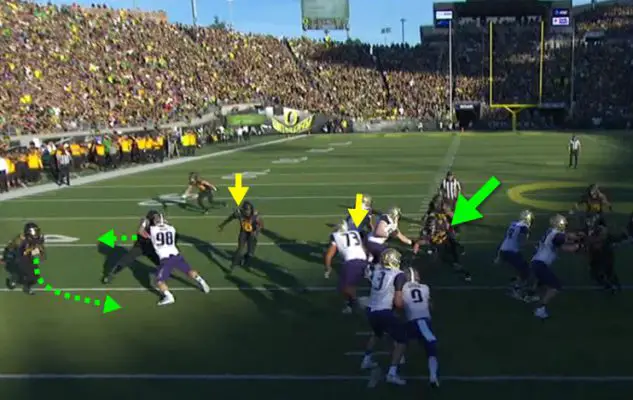
The moment of truth is about to arrive.
As you see above, all gaps are all accounted for with defenders, and the linebacker is approaching the pulling guard (No. 73). The technique used now will result in a tackle-for-loss by the defense, or a touchdown for the Huskies.
The key for the linebacker above is to NOT take on the offensive guard head-to-head, as he is outweighed by 80 pounds and will lose that confrontation every time. Instead his technique is to implement a “dip and rip” (we will cover this in another analysis) and for his outside shoulder to attack the inside shoulder of the guard as you see with the yellow arrows above.
This way the above linebacker will be inside the gap with the bulk of the large guard to the outside. Hence, the running back would have bounce outside, into the waiting tackle-for-loss by the Duck corner.
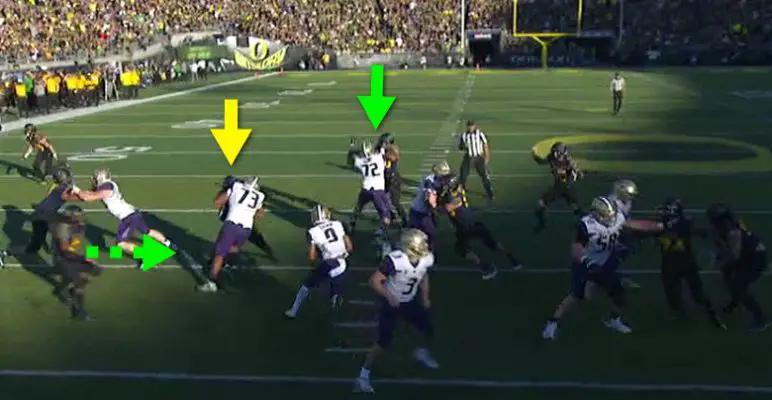
This is not what Brady Hoke wants …
Yikes. The Duck linebacker did the opposite of what we just walked through; he attacked the outside shoulder of the Husky offensive guard (No. 73) with his inside shoulder and is now being blocked effectively (yellow arrow above), leading to a large hole right through the heart of the defense. Meanwhile, the middle linebacker has allowed the UW offensive tackle to cut him off (green arrow above). A running lane has clearly formed …
Note how both the defensive end above and the blitzing corner would have smothered the running back had he been “spilled” to the outside as planned.
Linebackers (above) always want to attack the side of a blocking offensive lineman and get into his assigned gap. As the Grizzled Ol’ Coach explained,
“When blockers have contact with the middle of the body of the defender, or the numbers, a block is made and the defender has failed his assignment.”
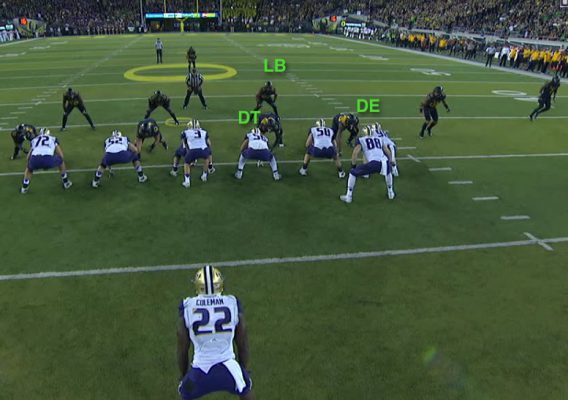
Lining up looks good for the Ducks.
Let’s take a look at another similar example. To begin the play above, we see the defensive tackle on the outside shoulder again and note the positioning of the defensive end in a “6-technique,” head-on the tight end, likely with “D-Gap” responsibility. It is the linebacker again that makes-or-breaks this play.
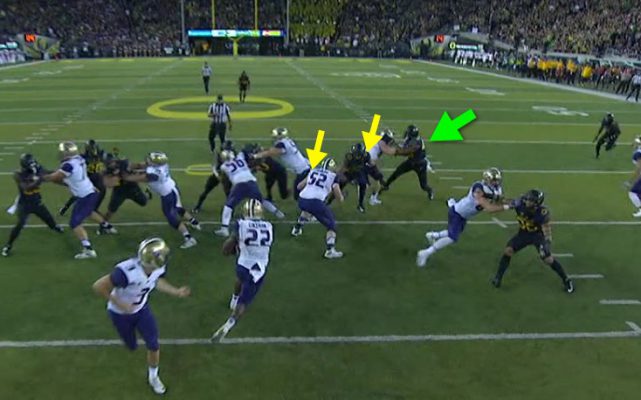
The moment of truth for this play …
The crucial moment is illustrated above. We want to see the linebacker take his outside shoulder and drive it up the armpit of the inside shoulder (see yellow arrows above) of the pulling offensive guard (No. 52). In doing so, the Oregon linebacker would be in the inside gap, with the size of the guard taking up the remaining space. Hence, the linebacker would “spill” the running back outside to the Duck defensive end (green arrow above) for a tackle of little to no gain.
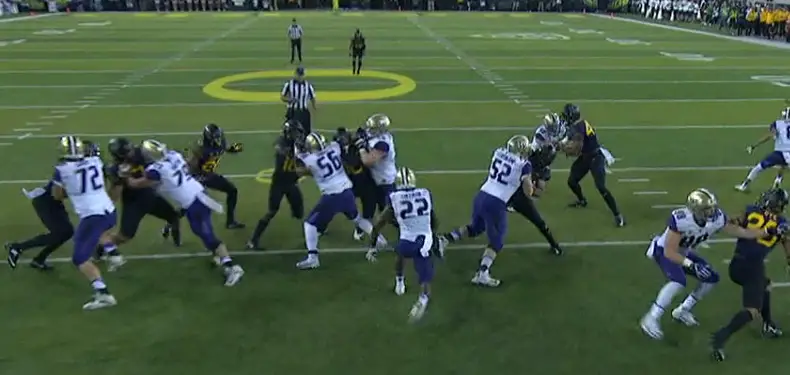
Oh, crap.
Instead, the Oregon linebacker does the opposite, as you see the dreaded contact on the linebacker’s numbers by No. 52, and a perfect running lane formed up the gut of the Duck defense.
Stuffing the play above was possible with the right technique!
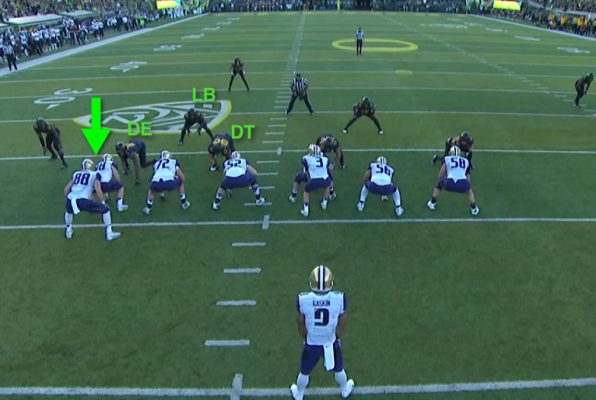
We are not lined up right and it is a killer …
Now we have an example of the linebacker getting better and doing it right! But then the Oregon defensive right end takes the wrong gap and ruins the execution for the Ducks. The defensive tackle above is in the usual “3-technique” location, and the linebacker featured is in his correct position. The defensive end is lined up (as previously seen) as a “6-technique,” head up on the Husky tight end, with D-Gap responsibility.
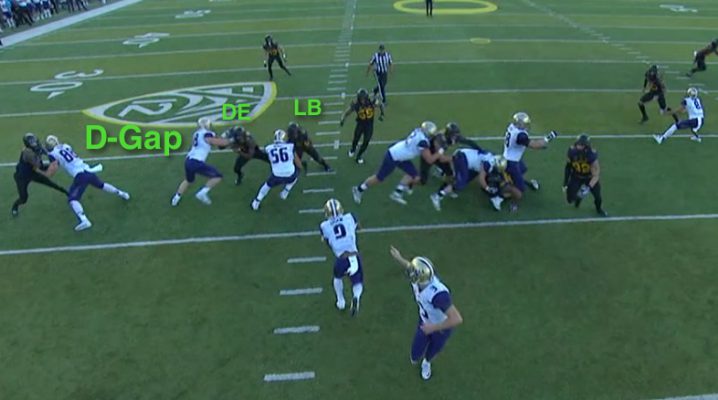
The D-Gap is wide open!
Here, the linebacker above fills the gap and attacks with his outside shoulder, forcing the running back outside. But now the D-Gap is wide open.
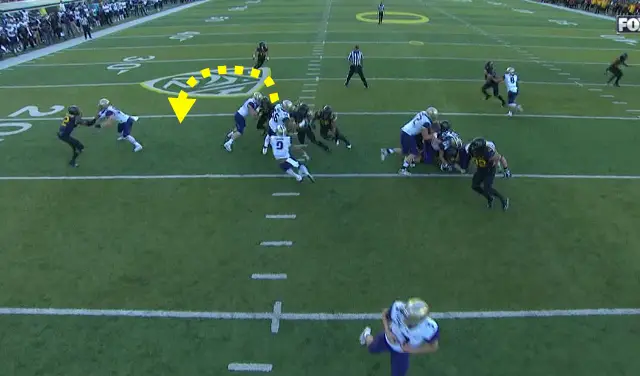
Oh, the what-ifs?
The linebacker has done a wonderful job filling and spilling his gap, but the running back is headed to a wide open running lane. If the defensive end had correctly taken the D-Gap to his outside, instead of the C-Gap to his inside, he would have been smack dab in what is now the open gap and the play could have been a no-gainer or a tackle-for-loss.
So, the linebacker above is improving and attacking the correct shoulder and maintaining gap integrity. But just one Duck defender takes the wrong gap, and Oregon gives up a big play. On the occasional series when this defense works together correctly across all 11 players, they can get the opposing offense off the field.
Coach Morris spoke to how this makes you ponder that the Ducks are not necessarily being blown off the field by superior talent; when they execute their assignments and use the correct technique – they can prevail. It is simply a matter of consistent execution across the board.
Oregon is a long way from that, and it has become evident the transition back to a 4-3 is much more difficult than originally thought. Last week we looked at how the defensive tackles need to improve their techniques to help the linebackers, and that analysis, together with this one, help us learn defensive concepts while understanding what went wrong for the Ducks on the field.
Let’s continue to learn more football, as it helps us enjoy this wonderful game of college football whether we win or lose.
“Oh how we love to learn about our beloved Ducks!”
Charles Fischer (FishDuck)
College Football Analyst for FishDuck.com
Eugene, Oregon
Top Photo from Video

Charles Fischer has been an intense fan of the Ducks, a season ticket holder at Autzen Stadium for 35 years and has written reports on football boards for over 23 years. Known as “FishDuck” on those boards, he is acknowledged for providing intense detail in his scrimmage reports and in his Xs and Os play analyses. He and his wife Lois, have a daughter Christine, reside in Eugene Oregon, where he was a Financial Advisor for 36 years and now focuses full-time on Charitable Planned Giving Workshops for churches and non-profit organizations.
He does not profess to be a coach or analyst, but simply a “hack” that enjoys sharing what he has learned and invites others to correct or add to this body of Oregon Football! See More…

